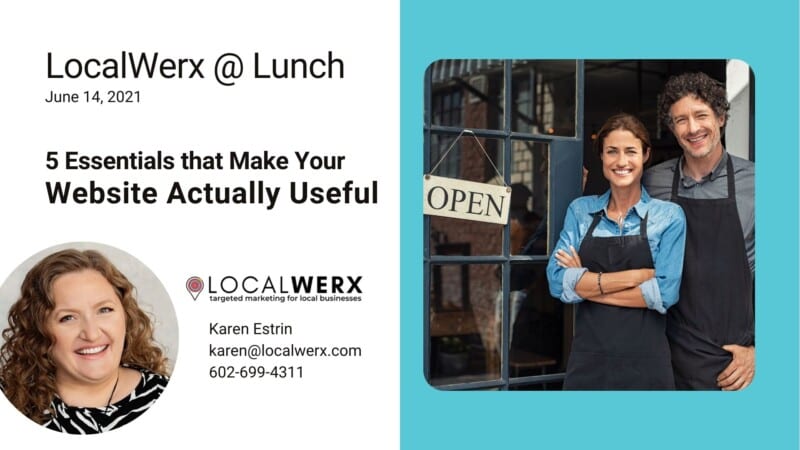Gone are the days of a “form over function” internet. Where once the simple novelty of seeing a business online, in any fashion, was often enough. Now, today’s more savvy audiences simply want to get where they are going. So with the priorities of today’s business websites being speed and ease of use, here are 5 essentials that will make sure you are providing your customers the information they require in the best way possible to help you make conversions either on your site or in person.
Contact information or NAP (Name, Address, Phone) is the most important information you can have on the internet. Seems simple enough, yet many well-intentioned websites make this information difficult to find. Studies show that people will tend to look at the top left corner of your website first, like they’re reading a book. This is where the most important information should be, your contact info—don’t make customers scour the page looking for a way to find your business.
1. NAME: Who is the business?
You likely have a lot to say about your business so the real challenge here is the distillation of your story. Don’t forget to start with the basics, your name! You want to reassure visitors that they’ve found who their looking for.
Once you’ve got your top level information cased, consider designing a way for interested customers to learn even more about the business. There you can dive deeper into your history, philosophy, and share any achievements or media coverage your business has had in its past.
2. ADDRESS
Unless you’re an online retailer, your address is an essential part of your contact listing. But there are a variety of ways to share your location. Here is how we recommend it. Provide enough information so that Google maps can locate the business. For people in major cities, often times just your street address is sufficient. But if your business is a little tricky to find consider linking to a map application, or have the map right on the website. If you’re going that direction, make sure to use an accredited map engine like Google Maps, instead of a hand-drawn creation. People tend to be a lot more familiar with popular map formats and might get confused/scared at the sight of your beautiful artwork.
3. PHONE or contact info
If you’re a business than welcomes phone calls, don’t hide it! If you’d rather receive an email, make that clear and visible. You want customers to easily reach you. Businesses with multiple departments equipped with individual phone lines, might want to stick those on a “Contact Us” page. There’s no sense in cluttering your home page with 30 different phone numbers. Businesses should have one phone number on the homepage display to be a catch-all for any inquiries. Don’t forget an area code for those out-of-town customers. Make it easy for on-the-go customers to hit a button and have their mobile device ring the business instantly.
There is lots of data you can include in the contact information section. The trick is finding the balance of information overload vs. unnecessary vagueness.
4. Mobile-Friendly
According to Google, more than 50% of web traffic comes from mobile. There’s nothing worse than pulling up a site on your smartphone and fining a miniature version of a company’s website. It’s endlessly frustrating to have to zoom in, scroll across and forgetting trying to click a link or button!
The main goal is to have a mobile friendly or responsive website that provides good customer experience. Your visitors should see a visually appealing site, with simple and intuitive navigation. Your call to action should be prominent and easy to access. The site should load quickly and be easy to read on the small screen.
5. Call to Action!
A key component of your website, the call to action lets your visitors know what to do on your site, or how to do business with you. If you’re an e-commerce site, the next step may be to purchase a product or sign up for a newsletter. If your website supports a brick-and-mortar business the call-to-action might be “Schedule an Appointment” or “Visit us at 123 Main Street”. Whatever action you want site visitors to take next, it should be visible and clear on your website.
Conclusion
A lot of people think a website should be an online version of your business. In reality, this is virtually impossible. A website is more like a messenger for your business. It’s a tool for relaying information about the business to potential customers and inviting them to interact with you. If your messenger is long-winded, confusing and tries to use flashy bright colours to grab attention, the customer is not going to be engaged. If your messenger relays all the information in a simple, concise and memorable way, customers will be much more likely to engage. It is quite likely a website is the first impression the customer might have of your business—remember, you only get once chance to make a first impression!


